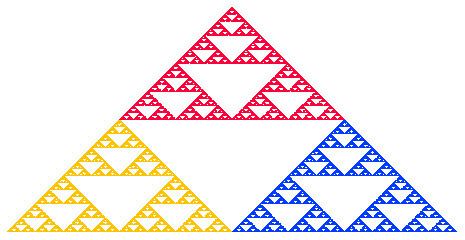 | ||
In mathematics, iterated function systems (IFSs) are a method of constructing fractals; the resulting fractals are often self-similar.
Contents
IFS fractals, as they are normally called, can be of any number of dimensions, but are commonly computed and drawn in 2D. The fractal is made up of the union of several copies of itself, each copy being transformed by a function (hence "function system"). The canonical example is the Sierpiński gasket, also called the Sierpiński triangle. The functions are normally contractive, which means they bring points closer together and make shapes smaller. Hence, the shape of an IFS fractal is made up of several possibly-overlapping smaller copies of itself, each of which is also made up of copies of itself, ad infinitum. This is the source of its self-similar fractal nature.
Definition
Formally, an iterated function system is a finite set of contraction mappings on a complete metric space. Symbolically,
is an iterated function system if each
Properties
Hutchinson (1981) showed that, for the metric space
The set S is thus the fixed set of the Hutchinson operator
The existence and uniqueness of S is a consequence of the contraction mapping principle, as is the fact that
for any nonempty compact set
Recently it was shown that the IFSs of noncontractive type (i.e. composed of maps that are not contractions with respect to any topologically equivalent metric in X) can yield attractors.
These arise naturally in projective spaces, though classical irrational rotation on the circle can be adapted too.
The collection of functions
Constructions
Sometimes each function
The most common algorithm to compute IFS fractals is called the "chaos game". It consists of picking a random point in the plane, then iteratively applying one of the functions chosen at random from the function system to transform the point to get a next point. An alternative algorithm is to generate each possible sequence of functions up to a given maximum length, and then to plot the results of applying each of these sequences of functions to an initial point or shape.
Each of these algorithms provides a global construction which generates points distributed across the whole fractal. If a small area of the fractal is being drawn, many of these points will fall outside of the screen boundaries. This makes zooming into an IFS construction drawn in this manner impractical.
Although the theory of IFS requires each function to be contractive, in practice software that implements IFS only require that the whole system be contractive on average.
Examples
The diagram shows the construction on an IFS from two affine functions. The functions are represented by their effect on the bi-unit square (the function transforms the outlined square into the shaded square). The combination of the two functions forms the Hutchinson operator. Three iterations of the operator are shown, and then the final image is of the fixed point, the final fractal.
Early examples of fractals which may be generated by an IFS include the Cantor set, first described in 1884; and de Rham curves, a type of self-similar curve described by Georges de Rham in 1957.
History
IFSs were conceived in their present form by John E. Hutchinson in 1981 and popularized by Michael Barnsley's book Fractals Everywhere.
"IFSs provide models for certain plants, leaves, and ferns, by virtue of the self-similarity which often occurs in branching structures in nature."
—Michael Barnsley et al.
